For a more premium walker option that’s a rather sustainable choice, the Sweet Cocoon Wooden Multi-Activity Baby Walker is stylish and fun. With an invisible and removable brake, to block the wheels and gradually release them, it allows you to safely control the speed of the wooden cart throughout the training. Featuring nine fun activities for your children, to help them to develop their fine motor skills, it’ll also keep them entertained and their brains stimulated.
Find out how our dad tester Chris found this walker when testing it out with his 11-month old daughter Hayley.
Pros
- Parents can decide how quickly the walker rolls forwards
- Very stable for supporting baby’s first steps
- Plenty of varied activities to entertain babies
- Felt-lined shape tray protects 3D shapes
- Appealing mix of plain wood and painted finishes
Cons
- Spinning grip rail
- Rubber wheels collect dust and hair
- Clicking spinner difficult for baby to use
Testing the Sweet Cocoon Wooden Multi-Activity Baby Walker
This walker was extensively tested over a month-long period by our daughter who at the time of writing this review is 11 months old. For the past month or so she has been able to pull herself up to standing on coffee tables, sofas etc., and lower herself back down again to sitting. She has also just begun cruising and taking steps while holding parent’s hands – the perfect time then to introduce a walker.
This particular walker, aged rated from one up to three years old, appealed because it includes a removable brake that allows the parent to control the speed at which the walker moves forwards; something that we thought would not only help our daughter quickly build confidence, but also prevent falls and accidents should the walker roll forward too quickly. With an impressive nine different activities, we also hoped it would keep her engaged, entertained and improve her motor skills and dexterity.
The retail price for this walker is £62.95, with online stores at time of writing stating prices between £48.74 and £57. As such, it is being pitched to parents as a premium item rather than a budget option, however there are a number of clever touches that impress and warrant this pricing. For example, the tray for wood shapes is felt-lined where on similar walkers it might just be plain wood. This not only muffles the noise of shapes being dropped into the tray but cushions them to prevent shapes’ corners being damaged or the tray itself being dented.
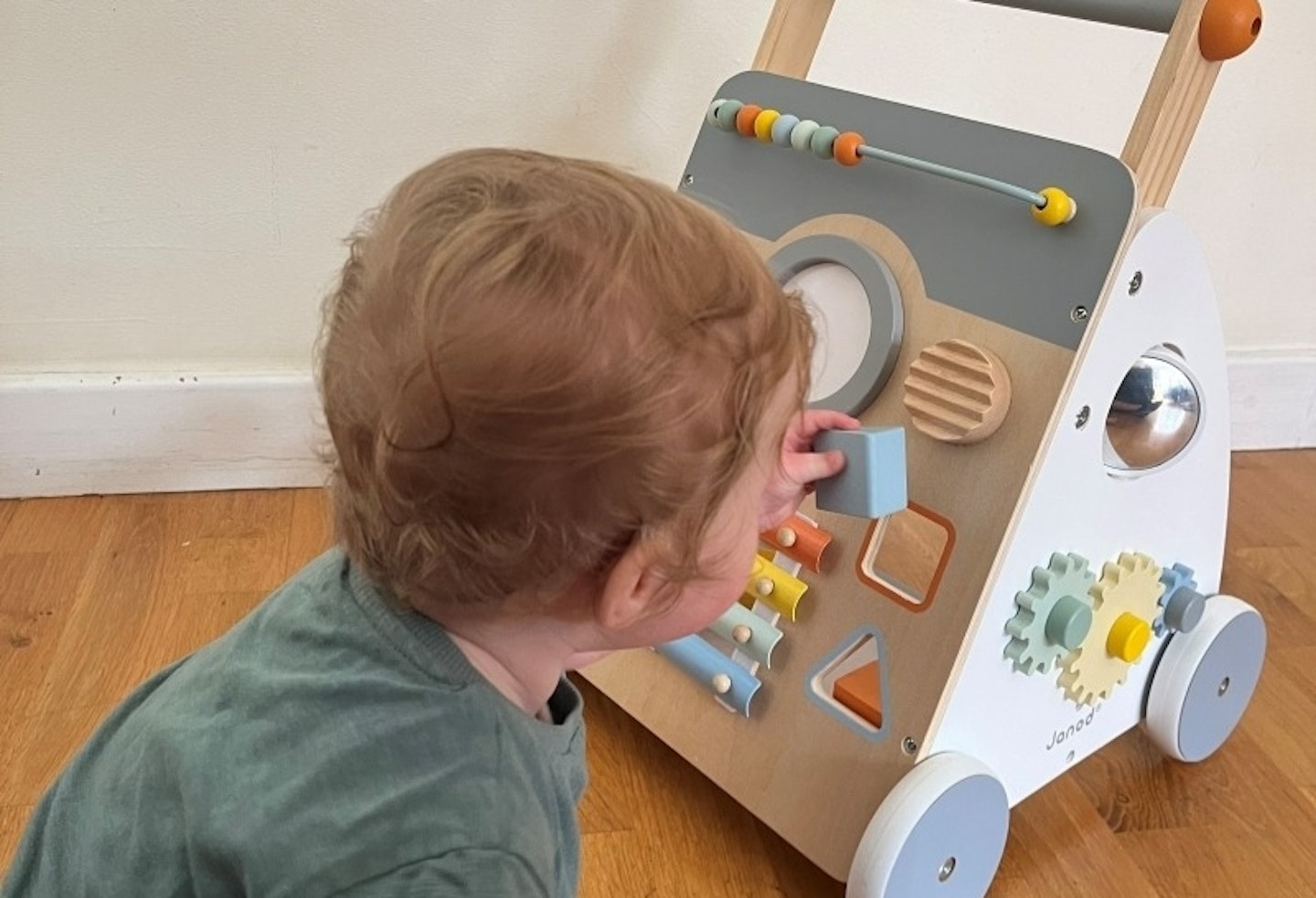
The overall appearance is attractive as well, using a combination of organic wood-grain finishes and muted white and grey painted surfaces so that the coloured activities draw baby’s attention.
Adjustability
The main adjustable feature of this walker is being able to slow down how quickly the rear wheels rotate. This is achieved using a pair of rubber spacers (one for each wheel) with a series of bobbles that create friction between the wheel and the side of the walker. They can be used to make the walker immobile or provide light braking force by tightening or slackening the fixings holding each wheel in place using the hex key provided. It’s a system that’s both simple and effective, with some trial and error involved in finding that right amount of braking for our daughter. As children grow, there’s also the option to remove the ‘brake’ spacers entirely and replace with the standard spacers provided to remove the braking force entirely.
As for the interactive elements of this walker, there’s a wire rail with beads, a clicking spinner, a ‘scratchy’ button, four coloured-recesses for corresponding coloured 3D shapes, a drum and four-bar xylophone with a pair of wooden mallets, spinning cogs, two-sided spinning mirror and a shape maze. We appreciate that thought has clearly been placed into spreading the different activities around the walker, rather than focusing the majority of them on the front.
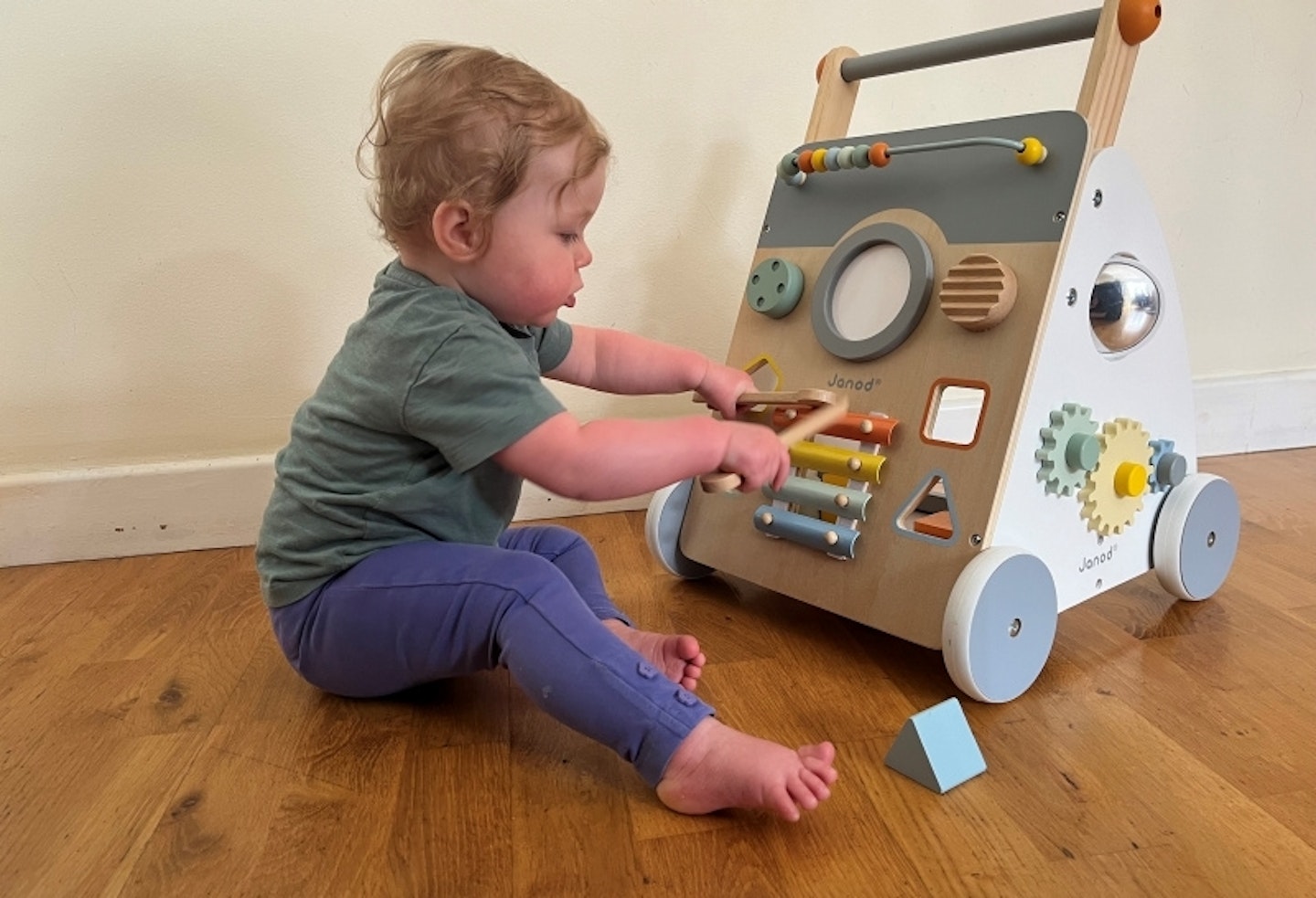
By far the favourite of our daughter is the xylophone and drum, followed the cogs and bead rail. The only activity she doesn’t use is the clicking spinner as she isn’t currently strong enough to turn it herself.
Manoeuvrability and ease of use
Although each of the chunky wheels spins independently (i.e. they’re not axle pairs) it’s not possible to turn this walker. It travels a linear route unless a parent lifts the walker and repositions it on baby’s behalf.
It’s extremely stable and the walker is able to support our daughter when she pulls herself to standing both from the activity side and the walking side, unlike other walkers that we have tested where applying weight from the activity side can result in the walker falling backwards. Likewise, we noted that walking while our daughter holds the grip bar over to one side, rather than evenly distributing her pushing force, does not result in the walker being unstable (i.e. tipping sideways).
The one slight quibble we have is that the grip bar spins – it isn’t fixed; though this may be an intended feature. However, my wife and I are in agreement that it would be safer if it didn’t rotate in position. The grip bar itself is wooden – there’s no additional coating (e.g. rubber) to increase grip. Nevertheless, our daughter seems to be able to easily to grip the bar.
Ease of storage
Weighing approximately 1.8kg, the walker can be lifted one-handed by a parent when it’s time to tidy away and the shape tray is deep enough to prevent the blocks and mallets from falling out when it is being moved around. It is though heavy enough to ensure that all four wheels remain on the ground when it is being used by our daughter, even when the rear wheels are fully-braked. A low ground clearance compared to similar wooden walkers likely helps in this regard.
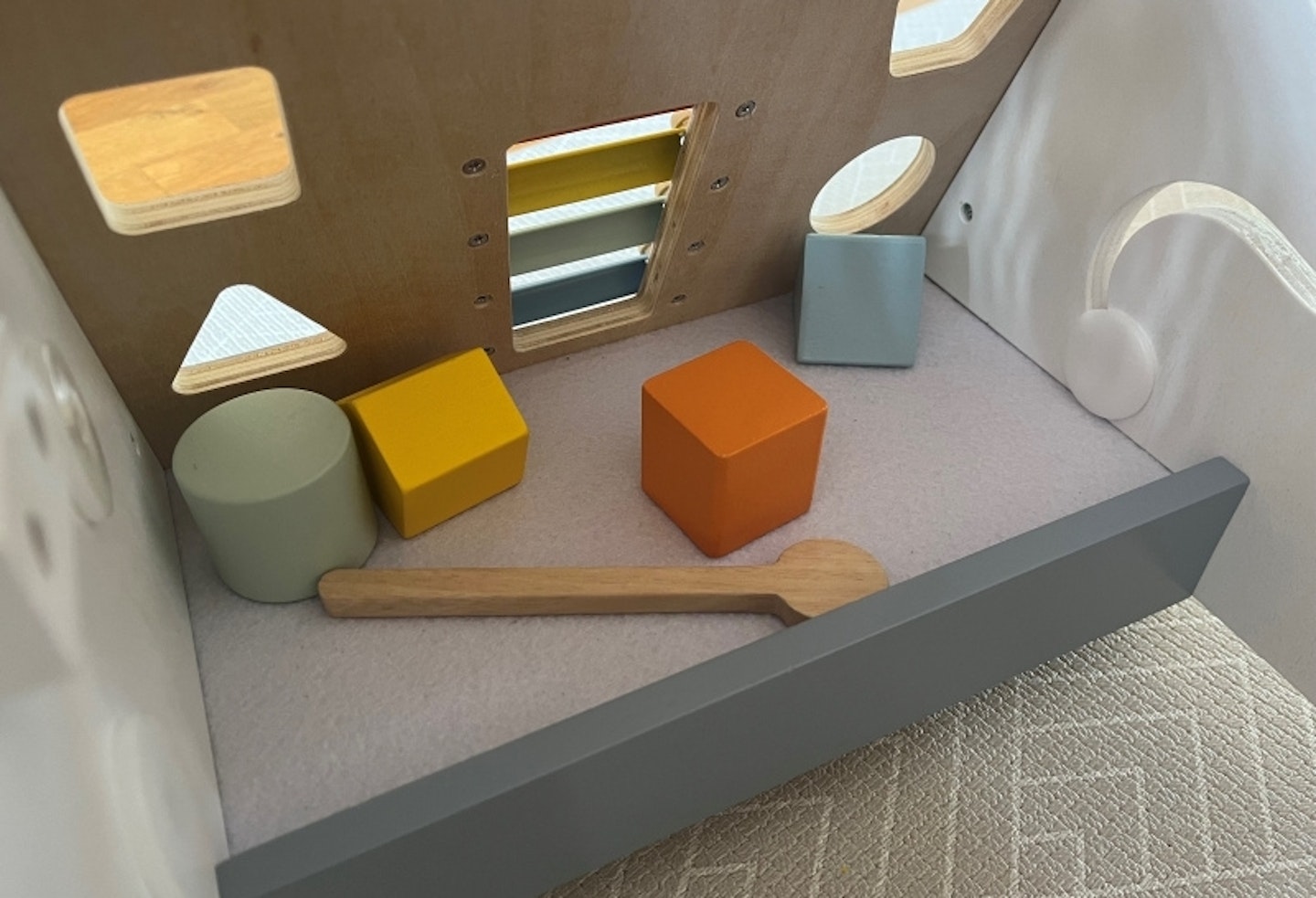
In terms of dimensions, at 34.5cm wide and 47.5cm tall it’s similar to other wooden walkers, though the length of 37cm means there’s a greater gap between the front and rear wheels than other walkers, which again helps to keep this walker stable.
Both the front and side panels feature rounded corners throughout – another appreciated safety feature.
Ease of assembly
Construction took approximately 20 minutes (the manufacturer suggests 30 minutes) and comprised fixing the shape tray and arms for the grip bar to the side panels before then securing the front panel and the wheels. A hex key is provided and the only other tool required was a cross-head screwdriver.
The instructions were straightforward and easy to understand with detailed illustrations. As such it was easy to identify the different fixings required at each stage of assembly.
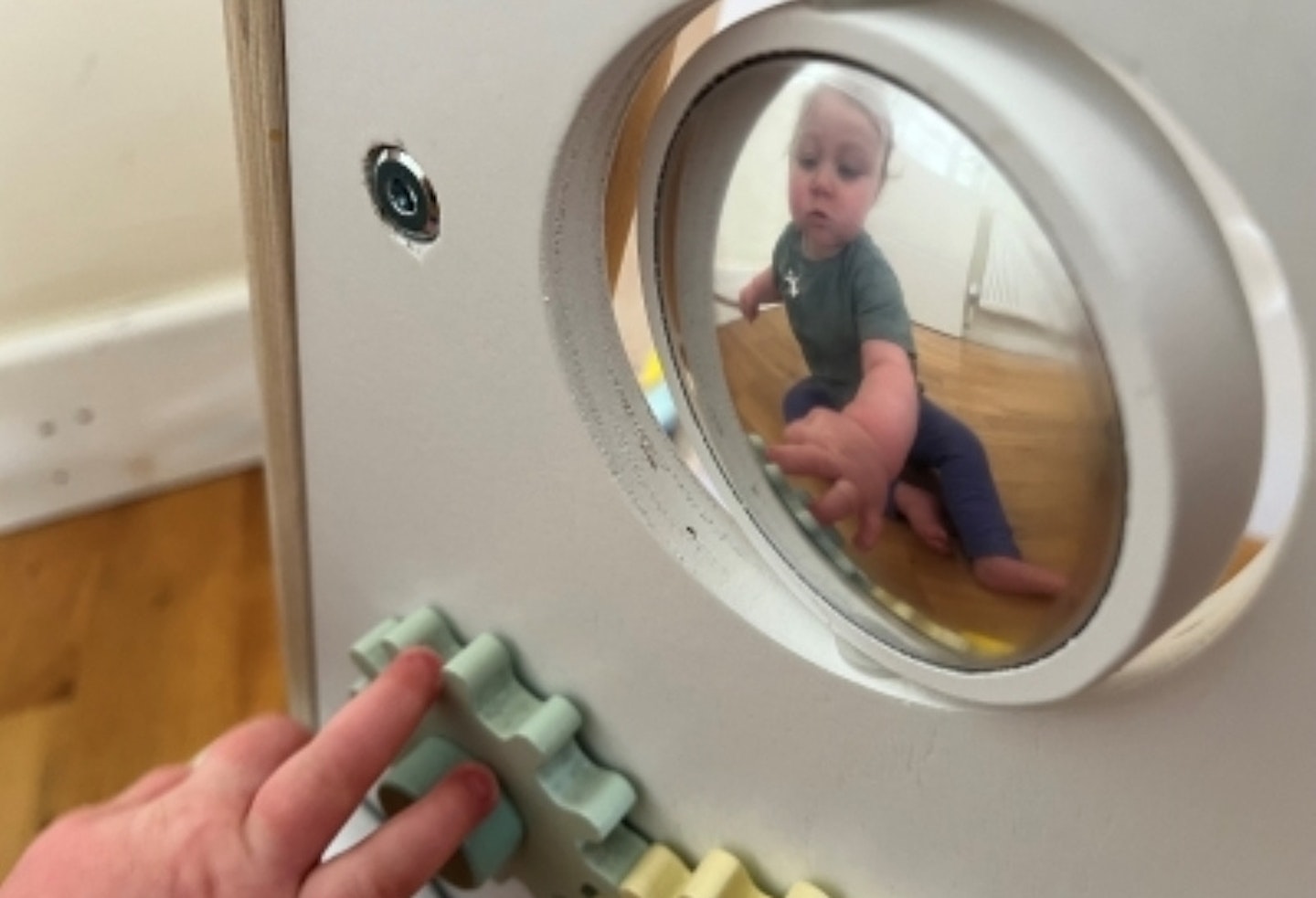
Ease of cleaning
Aside from the felt-lined tray, the walker can be wiped clean, with the manufacturer stating a damp clean cloth should be used that’s free from detergents. The walker was tested predominately on hardwood floors and while the rubber wheels offered good grip they do pick up dust and hair that can be quite unsightly so these, rather than the body of the walker itself, required cleaning most frequently.
The walker itself feels solid and durable. There’s no movement between the panels comprising the walker when it is rocked from side-to-side while the arms supporting the grip bar is thick enough to be very unlikely to split. The only panel that is thin enough to flex is the shape tray.
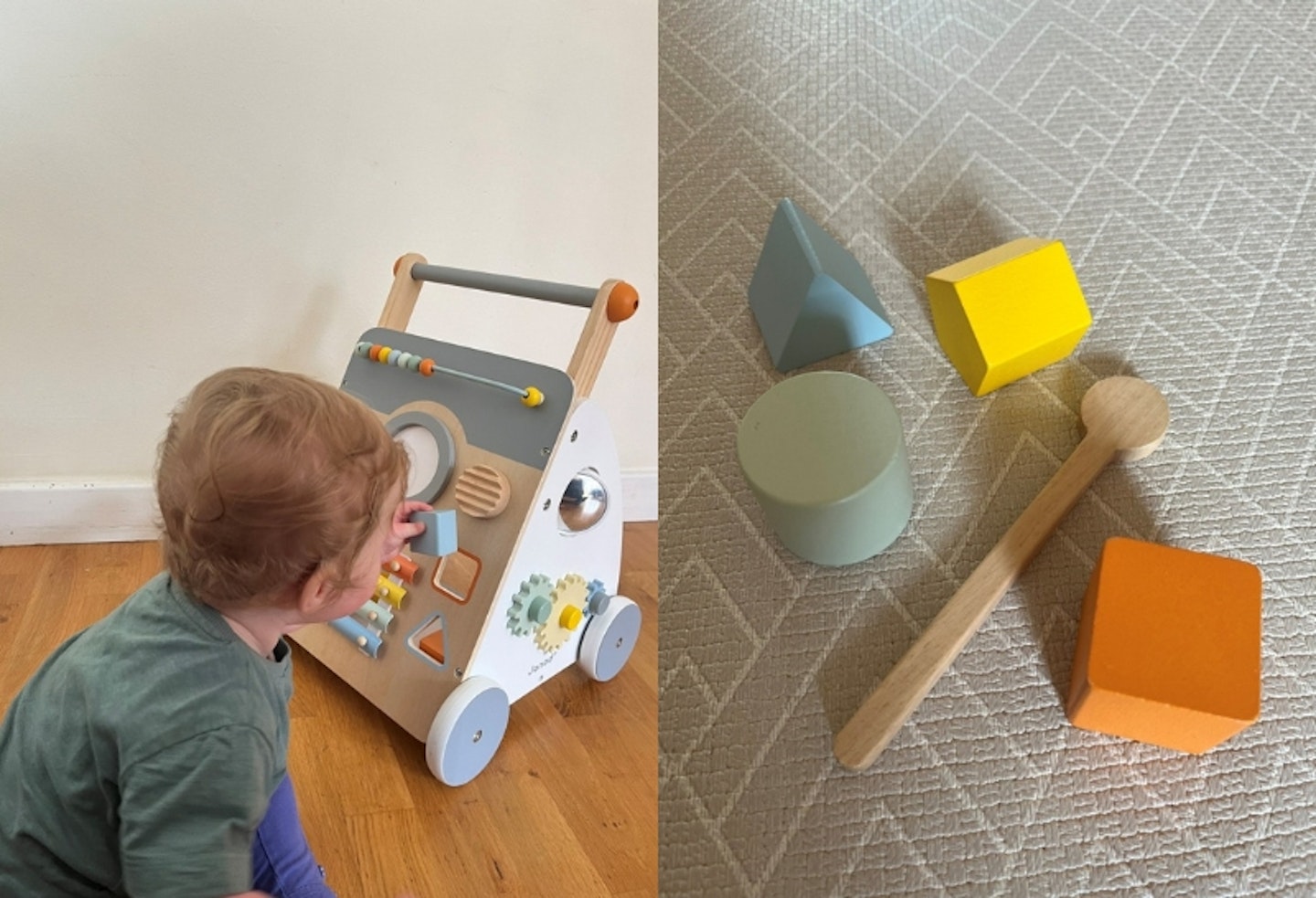
Final Verdict
This walker from French firm Janod has been a big hit with our daughter. When it is placed on her play mat she is quick to move to it and play with the various different activities and with the assistance of a parent is enjoying taking her first steps with it. The general impression we have of its design and the high-quality materials used is that it will last several years – easily beyond the two years it is intended for her use (i.e. one to three years old).
Drawbacks such are minor in the extreme and are vastly outnumbered by its many clever features.






